Roman artifacts provide a substantial reference to the brilliance and complexity of the Roman Empire, once a great civilization that left a deep imprint on Europe and beyond. Discovering these remains allows modern observers a glimpse into the ingenuity, beliefs, and daily lives of ancient Romans. From the remnants of grand statues that once honored emperors and deities to the intricate mosaics that decorated the floors of palatial villas, each artifact offers a story that contributes to our understanding of ancient Rome.
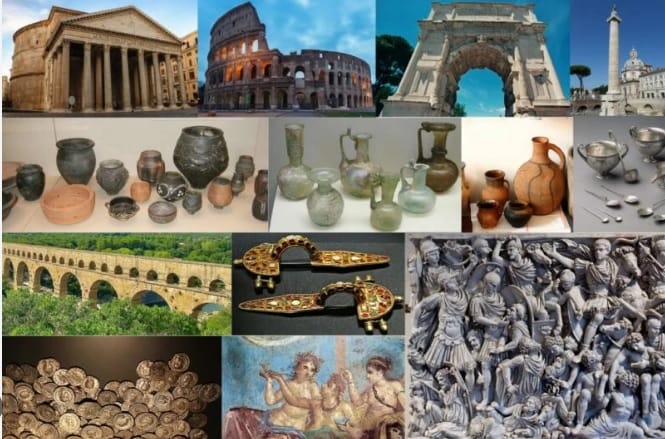
The preservation and study of Roman artifacts are crucial for piecing together the empire’s history. Through careful analysis, historians and archaeologists can reconstruct the past, shedding light on the roles these objects played in society. Jewelry pieces, for instance, reveal the craftsmanship and aesthetic preferences of Roman culture while answering questions about the status and wealth of their wearers.
Key Takeaways
- Roman artifacts reveal the sophistication and daily realities of ancient Rome.
- Careful study of Roman artifacts helps reconstruct historical narratives of the Roman Empire.
- The diverse range of Roman artifacts reflects a rich and complex culture.
Historical Context of Roman Artifacts
Roman artifacts provide an actual connection to the socio-political might of the Roman Empire and show the cultural practices of Ancient Rome.
Influence of the Roman Empire
The Roman Empire’s vast expanse from the British Isles to the Near East created a melting pot of influences that were reflected in the material culture. Objects ranging from coins to pottery carry the distinct marks of Roman dominance, with Latin inscriptions and Roman iconography serving as a testament to the influence of Roman governance.
Military Gear:
- Standardized armor pieces
- Helmets with typologies spreading across different provinces
Architectural Elements:
- Inscribed building blocks
- Decorative reliefs depicting Roman deities or victories
Roman artifacts not only symbolize military and political power but also demonstrate the logistical prowess in distributing materials across various provinces.
Cultural Significance in Ancient Rome
Within the Roman social hierarchy, artifacts were pivotal in both public and private spheres, often associated with identity, status, and domestic rituals.
Public Significance:
- Monuments: Celebrations of imperial triumphs
- Inscription Tablets: Documentation of laws and decrees
Private Sphere:
- Household Utensils: Indicators of wealth and social status
- Religious Reliquaries: Reflective of personal piety and the syncretic nature of Roman religion
Material culture provides insight into not just the habits and customs of Roman citizens but also the nuanced shifts in Roman culture throughout the Republic and Empire periods.
Top 10 Roman Artifacts:
Today’s artifacts are divided into special categories and therefore combined into their respective groups.
Roman Statues: Capturing Imperators and Deities
Whether sculpted from marble or cast in bronze, these statues range from exquisitely detailed depictions of emperors to symbolic representations of Roman deities.
1. The Augustus of Prima Porta
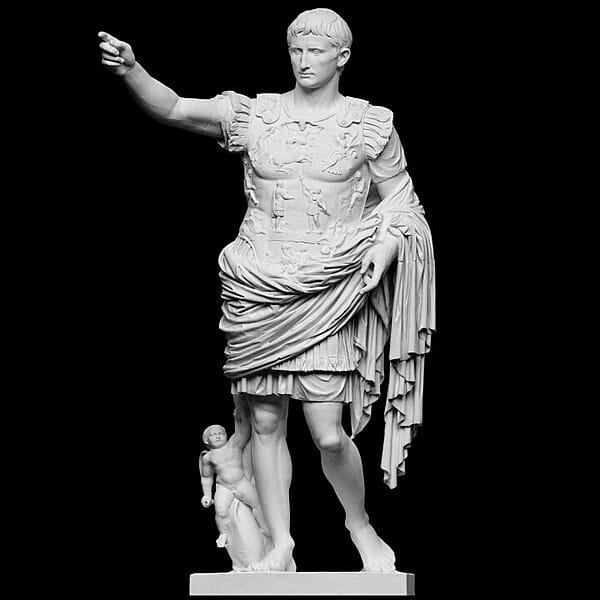
The Augustus of Prima Porta stands as a superior marble statue that embodies Roman imperial propaganda. Discovered in the villa of Livia, the statue presents Emperor Augustus in an idealized form with detailed iconography. His outstretched arm symbolizes his role as a military leader and orator, while the Cupid at his feet references his divine descent from the goddess Venus.
2. Equestrian Statue of Marcus Aurelius
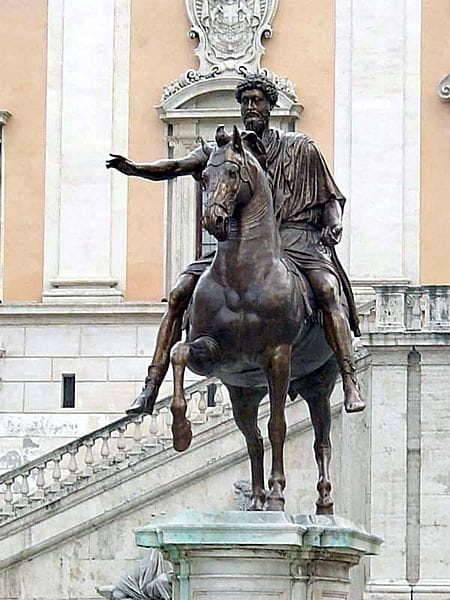
In stark contrast to the common fate of bronze statues that were often melted down, the Equestrian Statue of Marcus Aurelius survived, likely due to the mistaken identity of the emperor portrayed. This statue showcases Marcus Aurelius in military attire, commanding respect and emitting a sense of stoic calmness, a philosophy he famously practiced and promoted.
3. The Orator
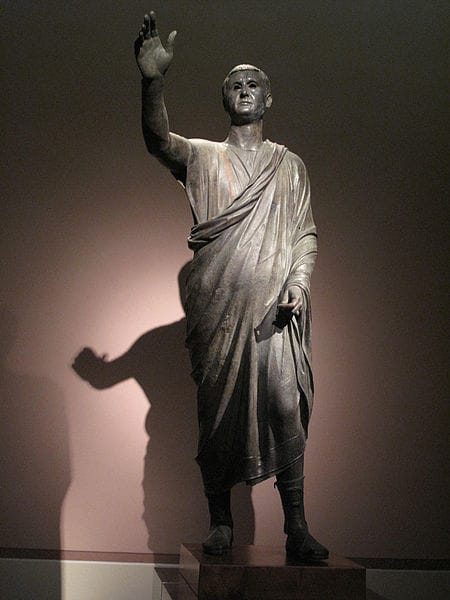
Source: National Archaeological Museum, CC BY 2.0 https://creativecommons.org/licenses/by/2.0, via Wikimedia Commons
The statue known as The Orator or Aulus Metellus is another exemplary bronze artifact. Its origin dates to the late Republic period, depicting an orator in the act of speaking. The realistic portrayal of clothing, such as the toga, and the attention to minute details like the lifelike hand gestures offer insight into the attire and public life of Roman figures.
4. Trajan’s Column
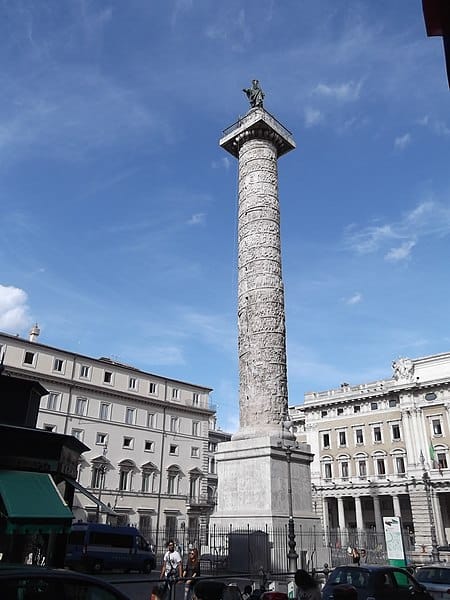
Source: karel291, CC BY 3.0 https://creativecommons.org/licenses/by/3.0, via Wikimedia Commons
While not a freestanding statue, Trajan’s Column is a monumental piece of architecture adorned with a spiral bas-relief that serves as a narrative artifact commemorating Emperor Trajan’s victory over the Dacians. The column’s sculptural frieze is a masterful chronicle of the Roman military campaign and an invaluable record of Roman armor, fortifications, and the daily life of both soldiers and civilians.
5. Portrait of the Four Tetrarchs
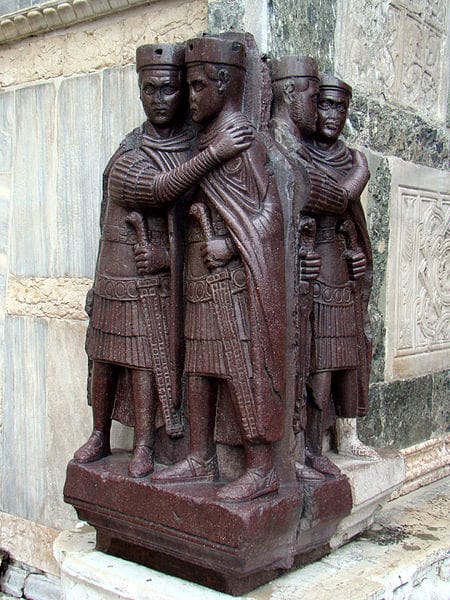
The Portrait of the Four Tetrarchs represents the concept of the Tetrarchy, where senior and junior emperors were paired to rule different parts of the Roman Empire. Carved from a stone chosen for its imperial connotations, porphyry, the group statue emphasizes the unity and equality of the four rulers over individual identity, as indicated by their nearly identical stylized features and embrace.
Other Famous Roman Artifacts
6. Colossus of Constantine
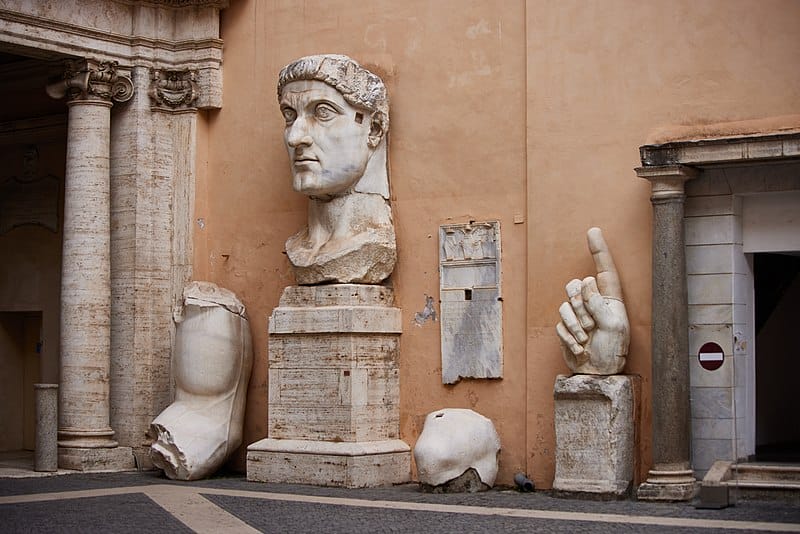
The Colossus of Constantine was an acrolithic statue, portions of which are now housed in the Palazzo dei Conservatori of the Capitoline Museums. This colossal figure originally depicted Emperor Constantine the Great and was made of a wooden core with marble fragments for the head, limbs, and drapery. Emperor Constantine was a significant figure in Roman history who initiated the expansion of Christianity in the Roman Empire. The preserved fragments of this statue, especially the head, are iconic examples of late Roman sculpture style and imperial portraiture. Today, there is a replica of the Colossus.
7. Capitoline Wolf
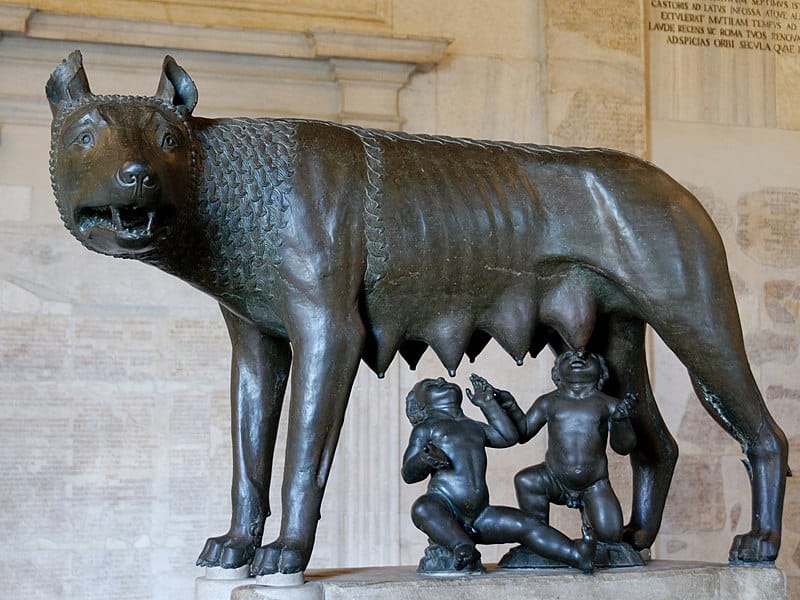
The Capitoline Wolf, an exquisite bronze sculpture depicting the mythical she-wolf nursing the twin founders of Rome, Romulus, and Remus, is another centerpiece among ancient Roman artifacts. Often, it is the first association of Rome. While the wolf figure is believed to be an Etruscan work from the 5th century BC, the figures of Romulus and Remus were added in the late 15th century. Displayed in the Capitoline Museums, this sculpture has grown to symbolize the city of Rome and its ancient origins. It excellently reflects the Roman appreciation for and adoption of earlier artistic traditions, which they then made their own.
Roman Mosaics
Roman mosaics are a great example of ancient Roman art, showcasing the skill and aesthetic sensibility of artisans from centuries past. These complex works often served decorative and practical purposes within Roman architecture. That’s why, they also deserve a place in our Top 10 category.
8. Alexander Mosaic – Pompeii
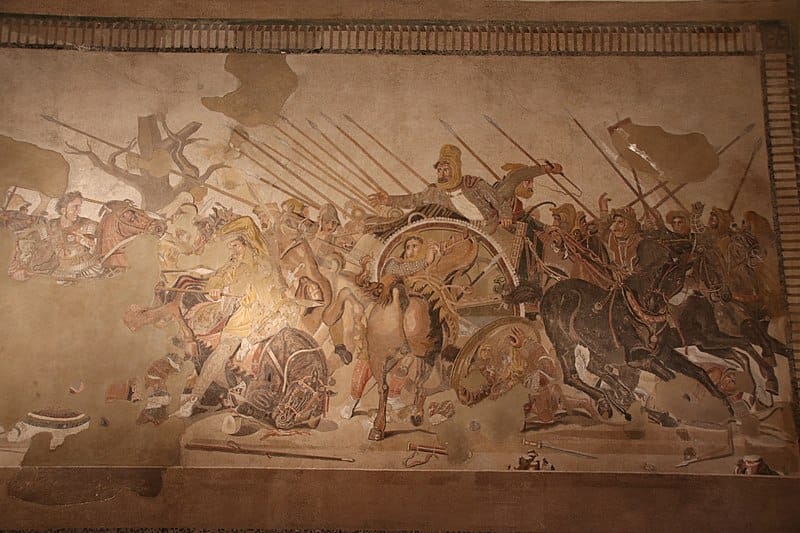
The Alexander Mosaic from Pompeii is a remarkable Roman artifact renowned for its intricate detail and historical significance. Found in the House of the Faun, the mosaic depicts the epic battle between Alexander the Great and Darius III of Persia. Even though it doesn’t represent Roman history it is a beautiful representation of Roman art.
This mosaic captures a precise moment in battle, portraying the intensity in the figures’ expressions and the dynamism of their postures. Art historians have deduced that the original artwork, which this mosaic likely copied, could be of Greek origin, emphasizing the cultural exchange between Greece and Rome.
9. The Gladiator Mosaic
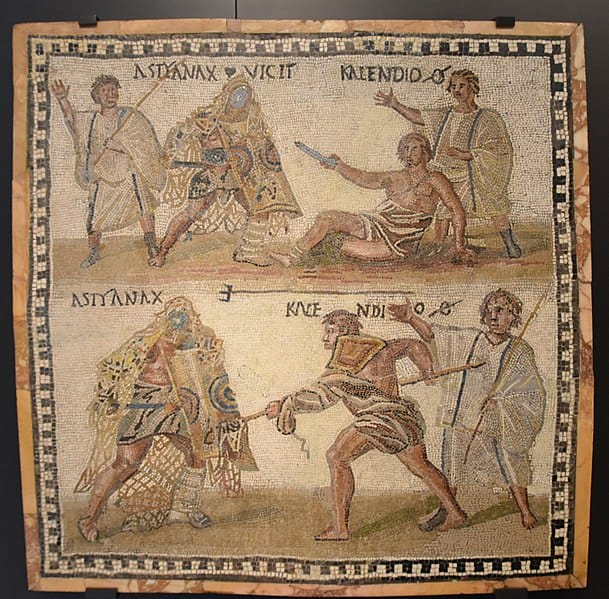
Another splendid example of Roman mosaics is the Gladiator Mosaic, discovered in the ancient city of Rome itself. It is a detailed depiction of ancient Roman gladiatorial combat, which provides insight into Roman culture and social entertainment.
This mosaic displays four figures, each labeled with a name, suggesting they could be representations of actual individuals from historic matches. The rich detail offers a glimpse into gladiators and reflects the value such spectacles held in Roman society.
10. Roman Jewelry
Roman jewelry represents a category for itself and that is why we gave all the Roman jewelry a place among the top 10. It is a reflection of the refined tastes and societal status, often indicating the affluence of the individuals who wore it. Characteristically fashioned from luxurious materials such as gold and silver, these pieces frequently featured an array of exquisite gemstones, including pearls, emeralds, and sapphires, which exemplified Roman craftsmanship.
Men and women in Roman culture both enjoyed an array of adornments. They wore an assortment of rings, earrings, necklaces, and brooches, each not merely serving a decorative purpose but also signifying their place in society. The intricacy involved in the creation of these items demonstrates Roman aesthetics and their commitment to beauty and expressive personal appearance.
Distinctive in their execution, such jewelry pieces played a pivotal role in the modern understanding of ancient cultures, acting as means through which current generations access the past. They stand not only as a testament to the Roman way of life but also bridge a connection to the artistic values that have influenced successive cultures.
The legacy of Roman artifacts, including jewelry, lives on, highlighting the influence of Roman culture on modern design and aesthetics. The mere existence of these artifacts provides a rich insight into historical practices, as well as the evolution of jewelry-making across millennia.
Conclusion:
Although there, are some other more familiar artifacts, we decided not to include them in this list for various reasons. Some are architectural wonders like Coloseum or Hadrian’s Wall and some are part of the literature like Ab Urbe Condita. Anyway, tell us in the comments what you think.
People Also Ask:
What are the top ten ancient Roman artifacts and their historical significance?
The top ancient Roman artifacts include items such as the Augustus of Prima Porta, the Roman Gladius, the Pompeii frescoes, the Bust of Julius Caesar, the Capitoline Wolf, the Vindolanda Tablets, the Colosseum’s structural remnants, the Pantheon’s dome, the Ara Pacis, and the Roman aqueducts. Each artifact holds immense historical significance, offering clues about Roman governance, military prowess, daily life, art, and engineering achievements.
Which famous ancient Roman artifacts can be seen in museums today?
Notable ancient Roman artifacts on display in museums include the Equestrian Statue of Marcus Aurelius in the Capitoline Museums, Rome; the Augustus of Prima Porta and the Livia’s Garden fresco in the Vatican Museums; the Altar of the Domitii Ahenobarbi at the Louvre, Paris; and the Silver Shekel of Judas, famously known as the “30 pieces of silver,” at the Israel Museum, Jerusalem.
What are some examples of Roman artifacts that are commonly included in school projects?
Common Roman artifacts that feature in school projects are Roman coins, pottery shards like amphorae or terra sigillata, Roman soldier armor fragments such as segments of a lorica segmentata, oil lamps, and replicas of famous sculptures such as the Laocoön Group.
Where can authentic Roman artifacts be purchased, and what are the legal considerations?
Authentic Roman artifacts can be acquired from reputable antiquities dealers, auctions, and sometimes from online marketplaces. Buyers must ensure that the items have verifiable provenance and the sale complies with international and national laws regarding cultural property, such as the UNESCO 1970 Convention on the Means of Prohibiting and Preventing the Illicit Import, Export, and Transfer of Ownership of Cultural Property.
What types of weapons are among the most notable artifacts from ancient Rome?
Among the most notable Roman military artifacts are weapons like the Gladius (short sword), Pilum (javelin), and Scutum (shield). These items were integral to the Roman army’s tactics and have been studied extensively to understand military innovations and strategies.
Which Roman sculptures have gained the most recognition for their artistic value?
Roman sculptures with great artistic value include the Laocoön Group, the Venus de Milo, and the Capitoline Venus. They are celebrated for their detailed workmanship and realistic portrayal of the human body, reflecting the high level of skill and aesthetics achieved by Roman sculptors.
Hello, my name is Vladimir, and I am a part of the Roman-empire writing team.
I am a historian, and history is an integral part of my life.
To be honest, while I was in school, I didn’t like history so how did I end up studying it? Well, for that, I have to thank history-based strategy PC games. Thank you so much, Europa Universalis IV, and thank you, Medieval Total War.
Since games made me fall in love with history, I completed bachelor studies at Filozofski Fakultet Niš, a part of the University of Niš. My bachelor’s thesis was about Julis Caesar. Soon, I completed my master’s studies at the same university.
For years now, I have been working as a teacher in a local elementary school, but my passion for writing isn’t fulfilled, so I decided to pursue that ambition online. There were a few gigs, but most of them were not history-related.
Then I stumbled upon roman-empire.com, and now I am a part of something bigger. No, I am not a part of the ancient Roman Empire but of a creative writing team where I have the freedom to write about whatever I want. Yes, even about Star Wars. Stay tuned for that.
Anyway, I am better at writing about Rome than writing about me. But if you would like to contact me for any reason, you can do it at contact@roman-empire.net. Except for negative reviews, of course. 😀
Kind regards,
Vladimir
